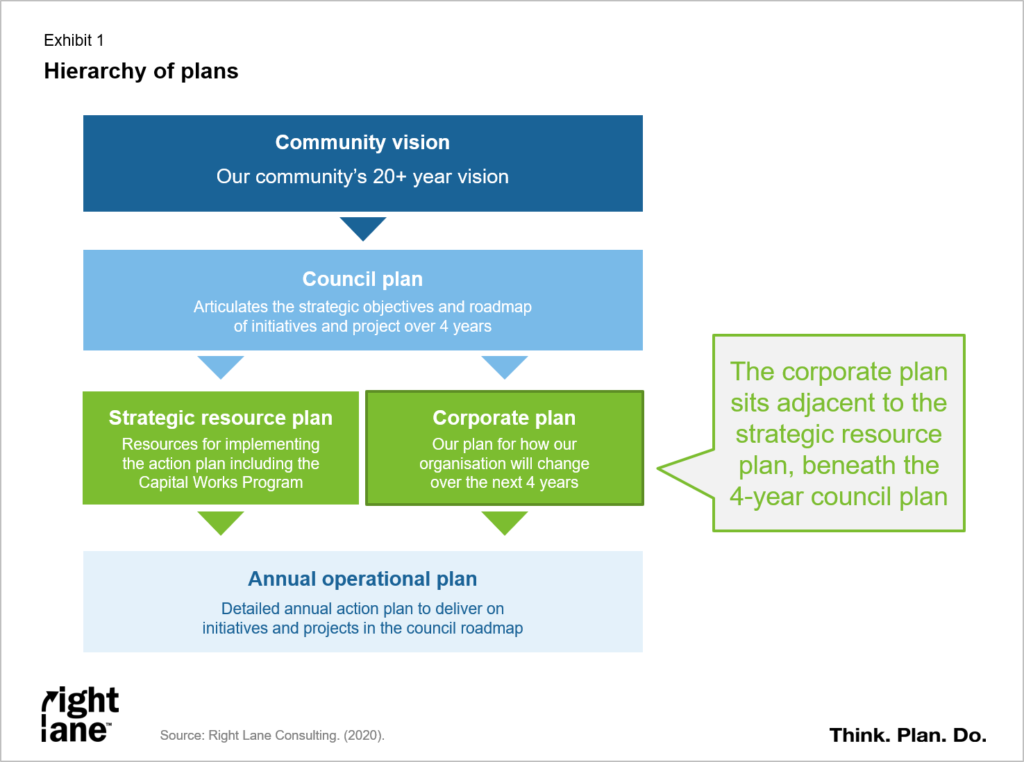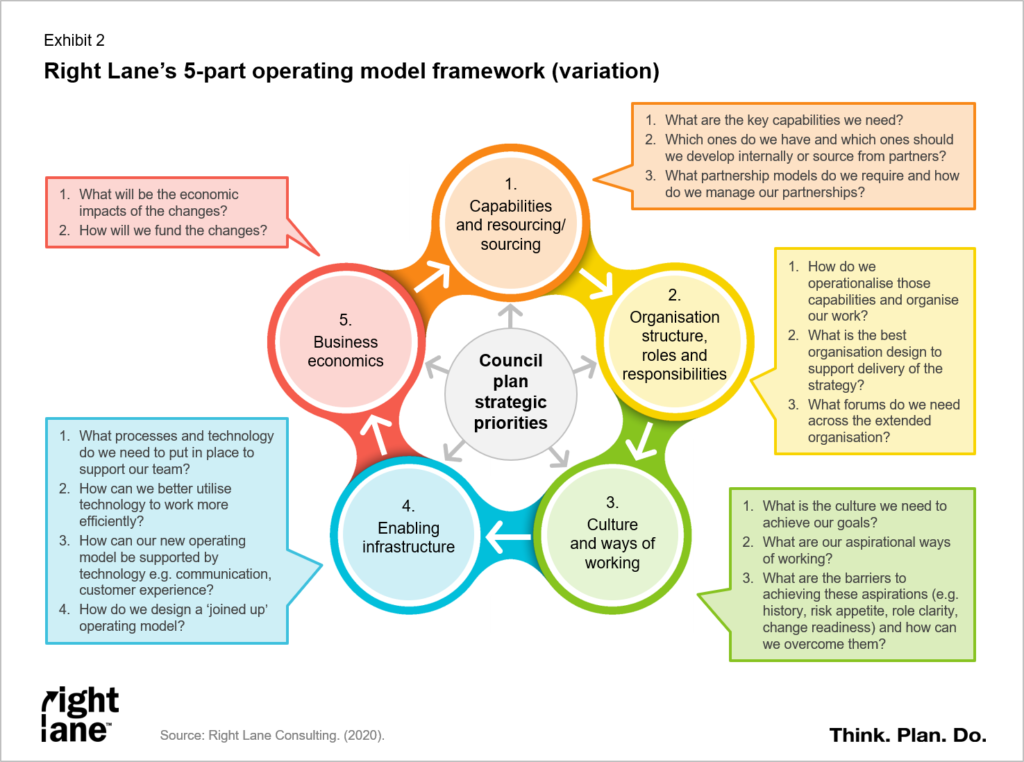Beyond the council plan – creating impact with a corporate plan
by Debbie Williams
Right Thinking
The council plan is an important strategic document that describes the outcomes council and the community want to see over the next 4 years and how council will achieve these outcomes. However, as the council plan is a public document, it tends to be outward looking – what council will deliver for the community – rather than addressing important internal issues that may limit council’s service delivery capacity, and therefore the ability to deliver the council plan.
One way to address this gap is to develop an internal corporate plan that sits alongside the public council plan.
A corporate plan may address elements including:
- required internal capabilities and resources
- organisation structure, roles and responsibilities
- culture and ways of working
- enabling infrastructure, including processes and technology.
When combined with the council plan, the corporate plan sets the council up to ensure the desired outcomes of the council plan can be delivered.
Why another plan?
The council plan plays an important role in setting the organisation’s direction and identifying ‘what are our priorities for the next 4 years?’, but it does not answer the equally important question ‘how will we set ourselves up for successful delivery of the plan?’.
A corporate plan helps you consider the cultural, organisational, and execution challenges and opportunities. Structures, systems, and processes that positioned you well for the last council plan may not be what is needed to deliver on new strategic priorities in a changing world. You may need to refocus your internal priorities to achieve the most effective outcomes for your community.
As an example, in our work with one of the large metro Melbourne councils, the CEO recognised that the council plan, although critical to the council’s future success, was not going to be sufficient to set the foundation for developing a high performing organisation. The council needed to fundamentally rethink what capabilities it required in its workforce, how it organised itself and its cultural norms. These were articulated through a corporate plan.
Some indications that a corporate plan might be particularly important this planning period include if:
- your organisation cannot adapt quickly to external disruptions, including those from COVID-19
- the council plan includes priorities that will require a significant investment of new resources
- it is unclear who is responsible for key strategic priorities
- organisational silos are hampering service delivery
- key processes are very manual and require a lot of handoffs
- innovation is stifled by the organisation culture, structure, or processes
- elements of your current operating model are internally focused rather than customer centric.
What is in a corporate plan?
The corporate plan sits underneath the council plan, adjacent to the strategic resource plan, and describes the organisation’s internal change agenda for the next 4 years.
Annual operational and action plans then need to clearly link to the priorities in the corporate plan, as well as those in the council and strategic resource plans. Refer exhibit 1.
At Right Lane, we use our operating model framework to challenge our clients to identify 4 categories of internal change priorities for the corporate plan:
- required internal capabilities and resources
- organisation structure, roles and responsibilities
- culture and ways of working
- enabling infrastructure, including processes and technology.
(Note: The fifth element ‘business economics’ is usually covered in the strategic resource plan.) Refer exhibit 2.
When should we develop a corporate plan?
It is important that the corporate plan responds to the specific priorities of the council plan, so work on the corporate plan cannot begin in earnest until the key elements of the council plan are agreed. We recommend developing the corporate plan in parallel to the strategic resources plan.
What is the process in developing a corporate plan?
The corporate plan development process can be more streamlined than the council plan process as key stakeholders are internal to the organisation. When the concept of a corporate plan is introduced to an organisation it is important to first clearly communicate to all staff why the plan is being developed and articulate a compelling change narrative.
A corporate plan is a great opportunity for emerging leaders to shape the organisation’s future. In this kind of work, we encourage our clients to establish a working group of high performers with leadership responsibilities to develop the draft corporate plan. We find this cohort is ideally placed to understand both the strategic imperatives and day-to-day reality of those in-service delivery roles.
With external support as required, the working group is asked to identify the areas of operating model that might need to change to successfully deliver the council plan, facilitate internal discussions across the organisation to diagnose issues that exist within the organisation today, identify potential solutions to the issues, and develop a long list of potential solutions for consideration by the executive team. The final corporate plan can then be developed based on the guidance of the executive team.
A corporate plan can help position a council for successful delivery of their council plan by articulating an internal change agenda. This can include a roadmap to build new internal capabilities, changes to the organisation structure, roles and responsibilities, initiatives to redesign key processes or implement enabling technology, and moving the organisation towards becoming a customer-centric, high performing culture.
Without a focus on getting the internal organisation match-fit for the challenges posed by the council plan, council risks not delivering the promise to the community that is made in the council plan. By adopting a corporate plan, councils can align their organisations to delivering the council plan and create the positive impact in the community that it envisions.
See more of Right Lane’s local government experience HERE
Right Lane’s partnership with LGiU includes a series of articles published by LGIU and distributed to their members and followers. You can find our LGiU published article ‘Strategic impact for local government: 5 ways to ‘power up’ your council strategic planning process’ HERE (LGiU member only access).
Or alternatively you can view it through the Right Lane website HERE
We hope the ideas presented here have given you something new to think about. We would love the opportunity to discuss them with you in more detail. Get in touch today.



